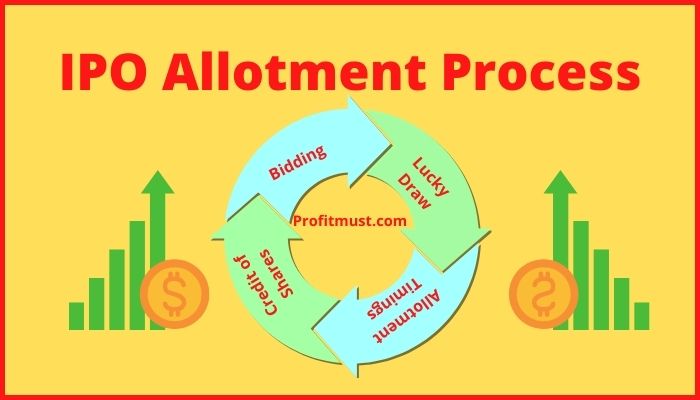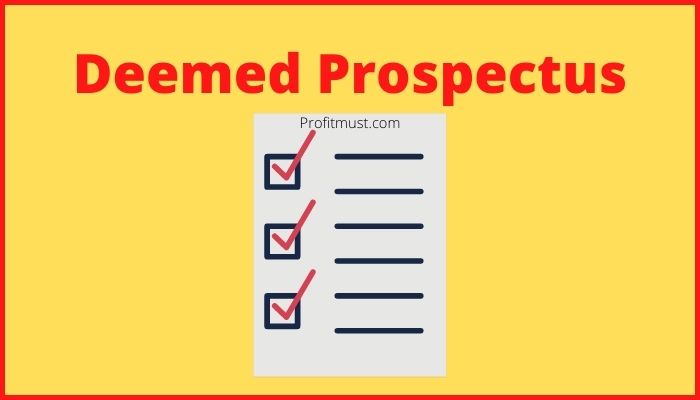The purpose of publishing a prospectus to the general public is to raise funds. However, there are 4 types of prospectus including Deemed Prospectus. We will discuss Deemed Prospectus in detail but first let’s understand what is Prospectus?
Table of Contents
What is Prospectus?
It is a legal document that describes the firm’s stocks or equities that have been made available to the public. Any circular, advertisement, notification, or manuscript that serves the aim of seeking proposals from the general public for the buying of a firm’s equity or stocks serves as a document.
The purpose of publishing a prospectus to the general public is to raise funds. A prospectus provides investors with the required and complete information about the company ‘s shares that are being sold, allowing them to make informed decisions about investing in the firm’s shares.
It is essential for the issuing company to submit the prospectus with the regulator before raising the fund.
Deemed Prospectus
A deemed prospectus, as the name implies, is a document that is deemed to be a firm’s prospectus. In principle, a prospectus is any offer by a corporation to sell its stock to the public that is provided in the form of a detailed document directed to the public.
Section 25(1) of The Company’s Act defines a deemed prospectus as a form of prospectus. The idea of deemed prospectus is particularly relevant when a corporation wants to issue shares through an intermediary in order to avoid SEBI compliance standards.
Deemed Prospectus Meaning
A document of Offer for Sale is created whenever a firm allots or agrees to allot its shares or securities to an intermediary, including a merchant bank, another company, or an issuing house, for the intention of eventually offering those shares for sale.
A deemed prospectus is a document that serves as an offer for sale. If it meets either of the following two criteria:
-
Criteria 1
Condition 1: The intermediary’s Offer for Sale to the Public was made within 6 months of the firm’s allotment of stocks to the intermediary;
-
Criteria 2
The company that allotted its shares to the intermediary received no consideration for the stocks until the date the intermediary’s Offer for Sale was made.
Things to keep in mind
If one of these two conditions is met, the document in which the intermediary presents the Offer for Sale is deemed to be a prospectus of the firm that issued its shares to the intermediary.
In this instance, all of the content and liability rules that apply to a firm’s prospectus also apply to a deemed prospectus.
The idea of a deemed prospectus is used here to clarify that even if an intermediary produced an offer for sale document, it will still be considered a prospectus issued by the original firm.
This assists in determining who is responsible for the shares’ original issuer.
Example Of Deemed Prospectus in Company Law
Let’s say a firm called Abc Ltd. wants to sell its stock to the public without having to comply with the law or the SEBI recommendations. Abc Ltd. agrees to assign its shares to an issuing house in January 2020 for this purpose.
The issuing house in this case was an underwriting firm. Through an Offer for Sale document, this issuing house makes the shares of Abc Ltd. available to the general public.
The shares of Abc Ltd. are now available to the general public through the issuing house, rather than directly from XYZ Ltd. This Offer for Sale document has now been regarded to represent Abc Ltd’s prospectus.
-
Process
To directly issue shares to the general public, Abc Ltd. must follow Section 26 of the Company’s Act as well as SEBI recommendations. However, because Abc Ltd. desired to be free from regulatory compliance, it was unable to sell its shares to the general public.

Nevertheless, under Indian law, if a company uses another firm or issuing house to sell its stocks to the general public, the issuing house is considered the firm’s representative, and the document thus issued by the issuing house is regarded the deemed prospectus of the firm, Abc Ltd., if one of the following two scenarios is fulfilled.
-
Scenario 1
If Abc Ltd. agreed to issue or allot its shares to the issuing house in January 2020, the issuing house must make those shares available to the public within six months.
So, if the issuing house issued the shares to the public in April 2020, it meets the first criterion, and the Offer for Sale document can be considered the Abc Ltd prospectus.
-
Scenario 2
Abc Ltd. should not have received any compensation for its shares when the issuing house made them available to the public. The technique is similar to that of internet selling.
When a vendor sells their goods through an internet company, they are only compensated when the product is sold and money is created. Therefore, the second criterion is satisfied if Abc Ltd. does not get any consideration until the issuing house offers the shares to the public.
If any of these conditions are met, the paper is considered a deemed prospectus for Abc Ltd.
Prospectus’s Director
Another fascinating question is who would be the prospectus’s director. The issuing house’s director will be considered to be the director in the deemed prospectus because the prospectus was offered by the issuing house.
As a result, a deemed prospectus is defined as the assumption of a statement as a company’s prospectus.
What Deemed Prospectus contents?
The key subject elements must be addressed in the prospectus:
- Company information, including name, registered office address, and objects.
- Information on the Memorandum’s signatories, including their shareholdings.
- Information about the directors.
- Information about the shares being issued, as well as the issue’s class and voting rights.
- Amount of the minimum subscription.
- The sum due at the time of application, allotment, and subsequent calls.
- The issue’s underwriters.
- The firm’s auditors.
- The firm’s profit and losses were reported in audited reports.
Need of deemed prospectus
A prospectus was a document that offered extensive information on a firm and its offer to sell shares to investors.
However, if a firm attempts to offer shares through an intermediary or underwriter, and the prospectus is likewise issued by the underwriter, doubt may develop as to who is liable for the prospectus’ terms and conditions.
The concept of a deemed prospectus under the Companies Act clarifies this uncertainty by saying that the prospectus produced by the intermediary/underwriter shall be deemed to be the prospectus of the originating company itself if certain circumstances are met.
As a result, there is more transparency in company public offerings.

Other types of prospectus
There are three different sorts of prospectuses, according to the deemed prospectus companies act 2013.
-
Red Herring Prospectus
The price of the shares offered and the number of shares to be issued are not included in the red herring prospectus. The firm must submit this prospectus to the registrar at least three days before the opening of the offer and subscription list, as per the laws.
-
Shelf Prospectus
Section 31 of the Companies Act of 2013 mandates the use of a shelf prospectus. When a firm or a public financial institution offers one or more securities to the public, a shelf prospectus is issued.
A corporation must state the prospectus’s validity duration, which should not exceed one year. The validity period begins when the first offer is made available.
On future offers, there is no need for a prospectus. When filing a shelf prospectus, the organisation must provide an information memorandum.
-
Abridged Prospectus
Abridged prospectus is a memorandum that contains all of the prospectus’ key features as defined by SEBI. This style of prospectus contains all of the information in a concise fashion, allowing the investor to make informed judgments.
A corporation cannot provide an application form for the purchase of securities unless it is accompanied with an abridged prospectus.

Conclusion
SEBI plays an Important role in Prospectus as it approves all the Prospectus. Although companies need to fulfill the criteria of Prospectus.
This is all about Deemed Prospectus. Although, if you have any doubts you can just comment below.
Other Related Blogs to what is deemed prospectus?
Difference Between IPO and FPO
Frequently Asked Questions
What is deemed prospectus in company law?
When a firm permits or agrees to allot any of its shares, the document is deemed a prospectus via which the offer is made to investors.
What is shelf prospectus in simple words?
A shelf prospectus is a form of prospectus used by corporations who want to raise money by issuing several bonds. Before issuing securities, public limited businesses must first issue a prospectus. Any public limited corporation can issue a shelf prospectus to raise cash through several bond issuance.
Who will issue deemed prospectus?
When a firm allots or agrees to allot any of its shares with the intention of all or some of those securities being offered for sale to the public, any document used to make the offer for sale to the public is regarded to be a prospectus issued by the company for all purposes.
What is abridged prospectus?
Abridged prospectus is a brief overview of the prospectus that includes all relevant and material information submitted with the registrar. An abridged prospectus must be provided with the paperwork for the acquisition of securities issued by a firm, according to Section 33(1) of the Companies Act, 2013.
When should a statement in lieu of prospectus be issued?
When a firm does not offer its shares for public subscription, it issues a statement in lieu of prospectus. The prospectus must be distributed by the Public Limited Company, however it is not required in all circumstances.

